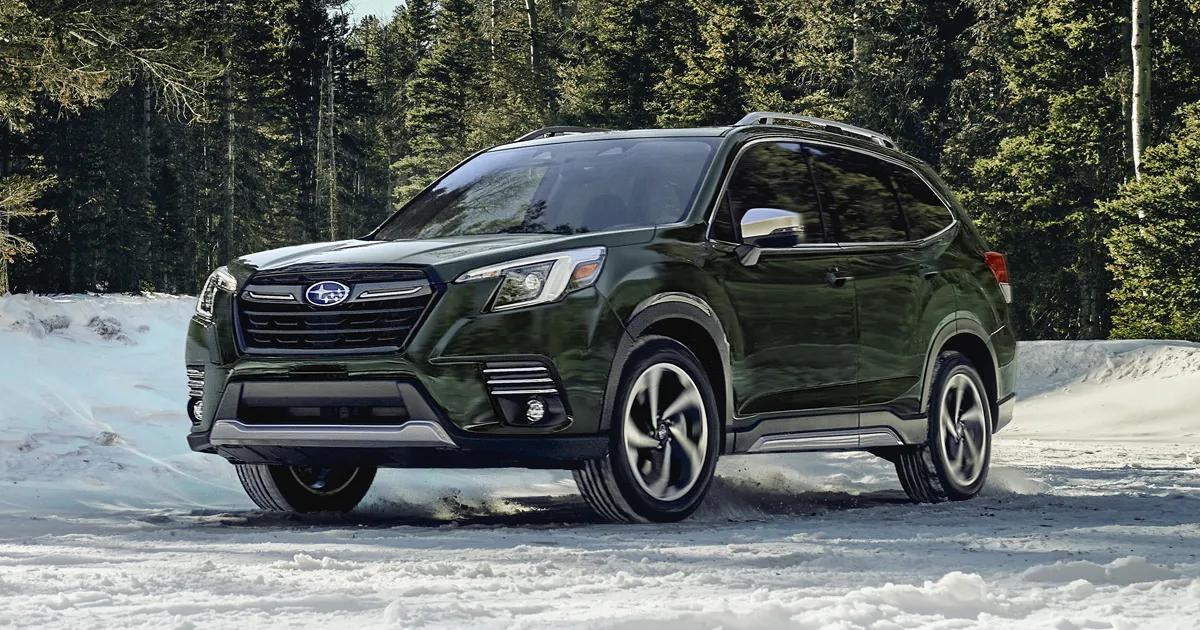Subaru Forester 2023“SRS Airbag System (Supplemental Restraint System airbag)” Base
The SRS (Supplemental Restraint System) airbag in the 2023 Subaru Forester is an essential safety element used to shield people in the case of an accident. Usually positioned throughout the car, this all-encompassing system consists of front, side, and curtain airbags to offer the best possible protection from different viewpoints. In order to improve passenger safety, the SRS Airbag System activates automatically when it detects a fast deceleration in a collision. This system works in tandem with seatbelts. This technology, which prioritizes passenger protection and ensures peace of mind for all occupants of the 2023 Forester, is an example of Subaru’s commitment to safety.
2023 Subaru Forester Specs, Price, Features, Mileage (Brochure)
SRS airbag (Supplemental Restraint System airbag)
Supplemental Restraint System (SRS) name is used because the airbag system supplements the vehicle’s seatbelts. This vehicle is equipped with a supple-mental restraint system which consists of seven airbags.
The configurations are as follows.
- Driver’s and front passenger’s frontal airbags
- Driver’s and front passenger’s side airbags
- Curtain airbags (for driver, front passenger, and window-side rear passengers)
- Knee airbag for driver
These SRS airbags are designed only as a supplement to the primary protection provided by the seatbelt.
The system also controls seatbelt pretensioners.
General precautions regarding SRS airbag system
WARNING
- To obtain maximum protection in the event of an accident, the driver and all passengers must always wear seatbelts when in the vehicle. The SRS airbag is designed only to be a supplement to the primary protection provided by the seatbelt. It does not eliminate the need to fasten seatbelts. In combination with seatbelts, it offers the best protection in case of a serious accident. Not wearing a seatbelt increases the chance of severe injury or death in a crash even when the vehicle has the SRS system.
- The SRS side airbags and SRS curtain airbags are designed only to be a supplement to the primary protection provided by the seat belt. They do not eliminate the need to fasten seatbelts. It is also important to wear a seatbelt to help avoid injuries that can result when an occupant is not seated in a proper upright position.

WARNING
The SRS airbags deploy with considerable speed and force. Occupants who are not seated in a proper upright position when the SRS air-bag deploys could suffer serious injury. Because the SRS airbag needs enough space for deployment, the driver should always sit upright and back in the seat as far from the steering wheel as practical while still maintaining full vehicle control, and the front passenger should move the seat as far back as possible and sit upright and well back in the seat.
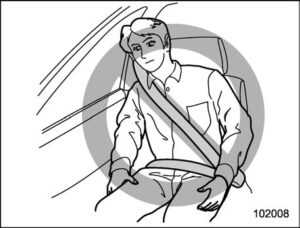
WARNING
- Do not sit or lean close to either front door. The SRS side airbags are stored in both front seat seatbacks next to the door, and they provide protection by deploying rapidly in the event of a side-impact collision. However, the force of SRS side airbag deployment can injure an occupant whose body is too close to an SRS airbag.
- Since your vehicle is equipped with SRS curtain airbags, do not sit or lean close to the front or rear door on either side. Do not put body parts out of the window. The SRS curtain airbags on both sides of the cabin are stored in the roof side (between the front pillar and a point behind the rear quarter glass), and they provide protection by deploying rapidly in the event of a side impact, rollover or an offset frontal collision. However, the force of its deployment can injure an occupant whose body is too close to an SRS airbag.
- Do not sit or lean unnecessarily close to the SRS airbag. Because the SRS airbag deploys with considerable speed and force to protect in high-speed collisions, the force of an airbag can injure an occupant whose body is too close to the SRS airbag.
- It is also important to wear seatbelts to help avoid injuries that can result when the SRS airbag contacts an occupant not in their proper position.
- Even when properly positioned, there remains a possibility that an occupant may suffer minor injuries, such as abrasions and bruises to the face or arms, because of the SRS airbag deployment force.

WARNING
- Keep arms away from either the front door or its internal trim. They could be injured in the event of SRS side airbag deployment.
- Do not place any objects over or near the SRS airbag cover or between you and the SRS airbag. If the SRS airbag deploys, these objects could interfere with its proper operation and could be propelled inside the vehicle, causing injury.
CAUTION
- When the SRS airbag is deployed, some smoke will be released. This smoke could cause breathing problems for people with a history of asthma or other breathing trouble. If you or your passengers have breathing problems after the SRS airbag deploys, get fresh air promptly.
- A deploying SRS airbag releases hot gas. Occupants could get burned if they come into direct contact with the hot gas.
NOTE
- When you sell your vehicle, we urge you to inform the buyer that the vehicle is equipped with SRS air-bags. Also, notify the buyer of the applicable section in this Owner’s Manual.
- If the SRS airbag deploys, the fuel supply will be cut off to reduce the risk of fire caused by leaking fuel.
General precautions regarding SRS airbag system for accessories and any objects
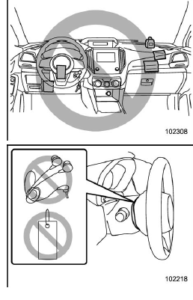
WARNING
- Do not put any objects (including straps or cords) over the steering wheel pad, column cover, or dashboard.
- These objects could be entangled with the steering wheel, preventing the SRS frontal airbag, etc. from operating properly.
- If the SRS frontal airbag de-ploys, these objects could be propelled inside the vehicle, causing injury.
- Do not put any objects under the driver’s side of the instrument panel. If the SRS knee airbag deploys, those objects could interfere with its proper operation and could be propelled inside the vehicle, causing injury.
- The key must not be attached to heavy, sharp, or hard accessories or another key. If the SRS knee airbag deploys, those objects could interfere with its proper operation and could be propelled inside the vehicle and cause injury.

WARNING
Do not attach accessories to the windshield or fit an extra-wide mirror over the inside rear view mirror. If the SRS airbag deploys, those objects could become projectiles that could seriously injure vehicle occupants.
WARNING
- Do not attach accessories to the door trim or near either SRS side airbags and do not place objects near the SRS side airbags. In the event of SRS side airbag deployment, they could be propelled dangerously toward the vehicle’s occupants and cause injuries.
- Do not attach a hands-free micro-phone or any other accessory to a front pillar, a center pillar, a rear pillar, the windshield, a side window, an assist grip, or any other cabin surface that would be near a deploying SRS curtain airbag. A hands-free microphone or other accessory in such a location could be propelled through the cabin with great force by the curtain airbag, or it could prevent correct deployment of the curtain airbag. In either case, the result could be serious injuries.
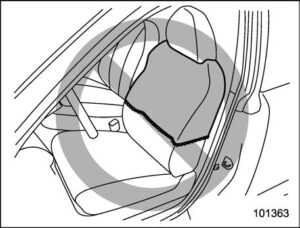
WARNING
- Do not put any kind of clothes or other objects over either front seatback and do not attach labels or stickers to the front seat surface on or near the SRS side airbag. They could prevent proper deployment of the SRS side airbag, reducing protection available to the front seat’s occupant.
- Do not install a seat cover unless it is a genuine SUBARU seat cover exclusively designed for use with the SRS airbag. Even when using a genuine SUBARU seat cover, the SRS side airbag system may not function normally if the seat cover is not installed correctly.
General precautions regarding SRS airbag system and children
 Seat children in the rear seat properly restrained at all times. The SRS airbag deploys with considerable speed and force and can injure or even kill children, especially if they are not restrained or improperly restrained. Because children are lighter and weaker than adults, their risk of being injured from deployment is greater. For that reason, we strongly recommend that ALL children (including those in child seats and those that have outgrown child restraint systems) sit in the REAR seat properly restrained at all times in a child restraint device or in a seatbelt, whichever is appropriate for the child’s age, height and weight. Secure ALL types of child restraint systems (including forward-facing child seats) in the REAR seats at all times. According to accident statistics, children are safer when properly restrained in the rear seating positions than in the front seating positions.
Seat children in the rear seat properly restrained at all times. The SRS airbag deploys with considerable speed and force and can injure or even kill children, especially if they are not restrained or improperly restrained. Because children are lighter and weaker than adults, their risk of being injured from deployment is greater. For that reason, we strongly recommend that ALL children (including those in child seats and those that have outgrown child restraint systems) sit in the REAR seat properly restrained at all times in a child restraint device or in a seatbelt, whichever is appropriate for the child’s age, height and weight. Secure ALL types of child restraint systems (including forward-facing child seats) in the REAR seats at all times. According to accident statistics, children are safer when properly restrained in the rear seating positions than in the front seating positions.
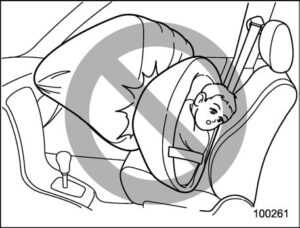
WARNING
NEVER INSTALL A CHILD RE-STRAINT SYSTEM IN THE FRONT PASSENGER’S SEAT. DOING SO RISKS SERIOUS INJURY OR DEATH TO THE CHILD BY PLACING THE CHILD’S HEAD TOO CLOSE TO THE SRS AIRBAG.

WARNING
Never allow a child to stand up or kneel on the front passenger’s seat. The SRS airbag deploys with considerable force and can injure or even kill the child.

WARNING
Never hold a child on your lap or in your arms. The SRS airbag deploys with considerable force and can injure or even kill the child.

WARNING
- Never allow a child to do the following.
- Kneel on any passenger’s seat facing the side window.
- Wrap his/her arms around the front seat seatback.
- Put his/her head, arms or other parts of the body out of the window.
In the event of an accident, the force of SRS side airbag and/or SRS curtain airbag deployment could injure the child seriously because his/her head, arms or other parts of the body are too close to the SRS side airbag and/or SRS curtain airbag.
- Since your vehicle is also equipped with a front passenger’s SRS frontal airbag, children should be placed in the rear seat anyway and should be properly restrained at all times.
Components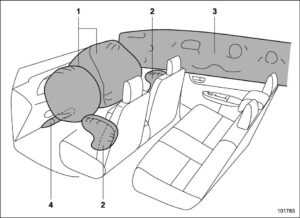
- SRS frontal airbag
- SRS side airbag
- SRS curtain airbag
- SRS knee airbag
The SRS airbags are stowed in the following locations.
Driver’s SRS frontal airbag: in the center portion of the steering wheel An “SRS AIRBAG” mark is located at the pad of the airbag.
Front passenger’s SRS frontal airbag: near the top of the dashboard An “SRS AIRBAG” mark is located on the dashboard.
SRS side airbag: in the door side of each front seat seatback which bears an “SRS AIRBAG” label
SRS curtain airbag: in the roof side (between the front pillar and a point behind the rear quarter glass) “SRS AIRBAG” marks are located at the top of each center pillar.
SRS knee airbag: under the steering column An “SRS AIRBAG” mark is located at the door of the airbag.

- Airbag control module (including impact sensor and rollover sensor)
- Frontal airbag module (driver’s side)
- Frontal airbag module (front passenger’s side)
- Front impact sensor (left-hand side)
- Front impact sensor (right-hand side)
- Side airbag module (driver’s side)
- Side airbag module (front passenger’s side)
- Side impact sensor (center pillar left-hand side)
- Side impact sensor (center pillar righthand hand side)
- Airbag wiring
- Seatbelt pre-tensioner and adaptive force limiter (driver’s side)
- Seatbelt pre-tensioner and adaptive force limiter (front passenger’s side)
- Side impact sensor (rear wheel house right-hand side)
- Side impact sensor (rear wheel house left-hand side)
- Curtain airbag module (right-hand side)
- Curtain airbag module (left-hand side)
- Seatbelt buckle switch (front passenger’s side)
- Knee airbag module (driver’s side)
- Front passenger’s occupant detection system sensor
- Front passenger’s occupant detection control module
- Front passenger’s frontal airbag ON and OFF indicator
- SRS airbag system warning light
- Side impact sensor (under the rear center seat)
- Side impact sensor (front door left-hand side)
- Side impact sensor (front door right-hand side)
- Lap belt pre-tensioner (front passenger’s side)
- Lap belt pre-tensioner (driver’s side) 28 Driver’s seat position sensor
- Passenger’s seat position sensor
- Rear seatbelt pre-tensioner (front passenger’s side)
- Rear seatbelt pre-tensioner (driver’s side)
SUBARU advanced frontal airbag system
Your vehicle is equipped with a SUBARU advanced frontal airbag system that complies with the new advanced frontal airbag requirements in the amended Federal Motor Vehicle Safety Standard (FMVSS) No. 208.
The SUBARU advanced frontal airbag system automatically determines the deployment force of the driver’s SRS frontal airbag at the time of deployment as well as whether or not to activate the front passenger’s SRS frontal airbag and, if activated, the deployment force of the SRS frontal airbag at the time of deployment.
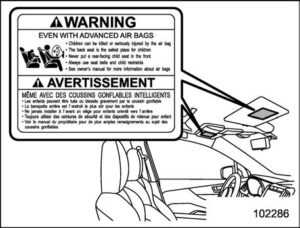
Your vehicle has warning labels on the driver’s and front passenger’s sun visors beginning with the phrase “EVEN WITH ADVANCED AIR BAGS” and a tag attached to the glove box lid beginning with the phrase “Even with Advanced Air Bags”. Make sure that you carefully read the instructions on the warning labels and tag. Always wear your seatbelt. The SUBARU advanced frontal airbag system is a supplemental restraint system and must be used in combination with a seatbelt. All occupants should wear a seatbelt or be seated in an appropriate child restraint system. In a moderate to severe frontal collision, the following components deploy.
- SRS frontal airbag for the driver
- SRS frontal airbag for front passenger. SRS knee airbag for the driver
- SRS curtain airbag*1
- When an offset frontal collision that is severe enough to deploy the front airbag occurs.
These components supplement the seatbelts by reducing the impact to the occupant’s head, chest, and knees.
Driver’s SRS frontal airbag
The driver’s SRS frontal airbag uses a dual-stage inflator. The inflator operates in different ways depending on the severity of the impact.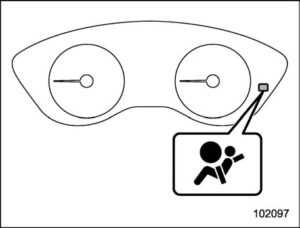
SRS airbag system warning light
Have the system inspected by your SUBARU dealer immediately if the SRS airbag system warning light illuminates.
NOTE
The driver’s SRS side airbag and SRS curtain airbag are not controlled by the SUBARU advanced frontal airbag system. Front passenger’s SRS frontal airbag The front passenger’s SRS frontal airbag uses a dual-stage inflator. The inflator operates in different ways depending on the severity of the impact.
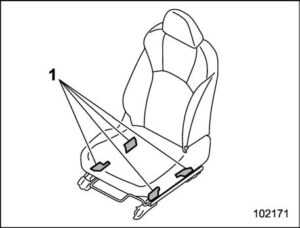
Occupant detection system sensors
The occupant detection system sensors are installed between the seat and seat rails, and monitor the physique and posture of the front passenger. Using this information, the occupant detection system determines whether the front passenger’s SRS frontal airbag should be deployed or not. The occupant detection system may not inflate the front passenger’s SRS frontal airbag even when the driver’s SRS frontal airbag deploys. This is normal. In this case, although the front passenger’s SRS frontal airbag does not operate, the front passenger’s seatbelt pre-tensioner operates with the driver’s seatbelt pretensioner.
CAUTION
Observe the following precautions. Failure to do so may prevent the SUBARU advanced frontal airbag system from functioning correctly or cause the system to fail.
- Do not apply any strong impact to the front passenger’s seat, such as by kicking.
- Do not let rear passengers rest their feet between the front seatback and seat cushion.
- Do not spill liquid on the front passenger’s seat. If liquid is spilled, wipe it off immediately.
- Do not remove or disassemble the front passenger’s seat.
- Do not install any accessory (such as an audio amplifier) other than a genuine SUBARU accessory under the front passenger’s seat.
- Do not place anything (shoes, umbrella, etc.) under the front passenger’s seat.
- Do not place any objects (books, etc.) around the front passenger’s seat.
- Do not use the front passenger’s seat with the head restraint removed. Do not leave any articles on the front passenger’s seat or the seatbelt tongue and buckle engaged when you leave your vehicle.
- Do not put sharp object(s) on the seat or pierce the seat upholstery.
- Do not place a magnet near the seatbelt buckle and the seatbelt retractor.
- Do not use front seats with their forward-backward position and seatback not being locked into place securely. If any of them are not locked securely, adjust them again.
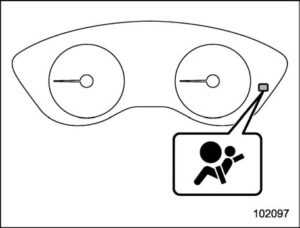
SRS airbag system warning light
If the seatbelt buckle switch and/or front passenger’s occupant detection system have failed, the SRS airbag system warning light will illuminate. Have the system inspected by your SUBARU dealer immediately if the SRS airbag system warning light illuminates. If your vehicle has sustained impact, this may affect the proper function of the SUBARU advanced frontal airbag system. Have your vehicle inspected at your SUBARU dealer. Do not use the front passenger’s seat while driving the vehicle to your SUBARU dealer.
NOTE
The front passenger’s SRS side airbag and SRS curtain airbag are not controlled by the SUBARU advanced frontal airbag system.
Passenger’s frontal airbag ON and OFF indicators

Front passenger’s frontal airbag ON indicator
Occupant detection system

Occupant detection system sensors
The occupant detection system sensors are installed between the seat and seat rails, and monitor the physique and posture of the front passenger. Using this information, the occupant detection system determines whether the front passenger’s SRS frontal airbag should be deployed or not.
WARNING
Do not kick the front passenger seat or subject it to severe impact. Otherwise, the SRS airbag system warning light may illuminate to indicate a malfunction of the front passenger occupant detection system. In this case, contact your SUBARU dealer immediately.
CAUTION
Electrical devices, such as cell phones, laptops, portable music players, or electronic games, especially when connected to the accessory power outlet and placed on the front passenger’s seat or used by the person sitting in the front passenger’s seat, may affect the operation of the occupant detection system. If either of the following situations occurs when using an electronic device in the vehicle, at first try to relocate that device to avoid it creating any interference.
- The SRS airbag system warning light illuminates.
- The front passenger’s frontal airbag ON and OFF indicators operate erratically.
If the device continues to cause interference, the use of that device in the vehicle should be discontinued.

If the front passenger’s seat cushion is wet, this may adversely affect the ability of the system to determine deployment. Wipe off liquid from the seat, let the seat dry naturally and then check the SRS airbag system warning light.
 If the front passenger’s frontal airbag ON and OFF indicators do not work properly even when the front passenger’s seat is dry, do not allow anyone to sit on the front passenger’s seat and have the occupant detection system checked by your SUBARU dealer.
If the front passenger’s frontal airbag ON and OFF indicators do not work properly even when the front passenger’s seat is dry, do not allow anyone to sit on the front passenger’s seat and have the occupant detection system checked by your SUBARU dealer.

Front passenger’s frontal airbag ON indicator
Front passenger’s frontal airbag OFF indicator
Also, if luggage or electronic devices are placed on the front passenger’s seat, this may adversely affect the ability of the system to determine deployment. This may prevent the front passenger’s frontal airbag ON and OFF indicators from working properly. Check that the indicators work properly. When the OFF indicator turns off and the ON indicator illuminates, the front passenger’s frontal airbag may deploy during a collision. Remove luggage and electronic devices from the front passenger’s seat.
Conditions in which front passenger’s SRS frontal airbag is not activated
The front passenger’s SRS frontal airbag will not be activated when any of the following conditions are met regarding the front passenger’s seat:
- The seat is empty.
- The seat is equipped with an appropriate child restraint system and an infant or a child is restrained in it.
- The front passenger’s occupant detection system is malfunctioning.
WARNING
NEVER INSTALL A CHILD RESTRAINT SYSTEM IN THE FRONT PASSENGER’S SEAT EVEN IF THE FRONT PASSENGER’S SRS FRONTAL AIRBAG IS DEACTIVATED. Be sure to install it in the REAR seat in the correct manner. Also, it is strongly recommended that any forward-facing child seat or booster seat be installed in the REAR seat and that even children who have outgrown a child restraint system be also seated in the REAR seat. This is because children sitting in the front passenger’s seat may be killed or severely injured should the front passenger’s SRS frontal airbag deploy. REAR seats are the safest place for children.
CAUTION
When the front passenger’s seat is occupied by an infant in an appropriate child restraint system, observe the following precautions. Failure to do so may interfere with the proper operation of the occupant detection system, activating the front passenger’s SRS frontal airbag even though that seat is occupied by the infant in the child restraint system.
- Do not place any article (including electronic devices) on the seat other than the infant in the child restraint system.
- Do not place more than one infant in the child restraint system.
- If the front passenger’s frontal airbag ON indicator illuminates and the OFF indicator turns off even when an infant or a small child is in a child restraint system (including a booster seat)
 Front passenger’s frontal airbag ON indicator
Front passenger’s frontal airbag ON indicator
- Turn the ignition switch to the “LOCK”/ “OFF” position.
- Remove the child restraint system from the seat.
- By referring to the child restraint manufacturer’s recommendations as well as the child restraint system installation procedures in “Child restraint systems”�P60, correctly install the child restraint system.
- Turn the ignition switch to the “ON” position and make sure that the front passenger’s frontal airbag ON indicator turns off and the OFF indicator illuminates. If the ON indicator still remains illuminated while the OFF indicator turns off, take the following actions.
- Ensure that no article is placed on the seat other than the child restraint system and the child occupant.
- Ensure that the backward-forward position and seatback of the front passenger’s seat are locked into place securely by moving the seat back and forth.
- If the ON indicator still remains illuminated while the OFF indicator turns off after taking the relevant corrective actions described above, relocate the child restraint system to the rear seat and immediately contact your SUBARU dealer for an inspection.
NOTE - When a child who has outgrown a child restraint system or a small adult is seated in the front passenger’s seat, the SUBARU advanced frontal air bag system may or may not activate the front passenger’s SRS frontal airbag depending on the occupant’s seating posture. Children should always wear a seatbelt when sitting in the seat irrespective of whether the airbag is deactivated or activated. If the front passenger’s SRS frontal airbag is activated (the ON indicator remains illuminated while the OFF indicator turns off), take the following action. the seat other than the occupant.
- If the ON indicator still remains illuminated while the OFF indicator turns off despite the fact that the actions noted above have been taken, seat the child/small adult in the rear seat and immediately contact your SUBARU dealer for an inspection. Even if the system has passed the dealer inspection, it is recommended that on subsequent trips the child/small adult always take the rear seat. Children who have outgrown a child restraint system should always wear the seatbelt irrespective of whether the airbag is deactivated or activated.
Conditions in which the front passenger’s SRS frontal airbag is activated
The front passenger’s SRS frontal airbag will be activated for deployment upon impact when any of the following conditions are met regarding the front passenger’s seat.
- When the seat is occupied by an adult. . When certain items (e.g. jug of water) are placed on the seat
- If the passenger’s frontal airbag OFF indicator illuminates and the ON indicator turns off even when the front passenger’s seat is occupied by an adult

- Front passenger’s frontal airbag ON indicator
- Front passenger’s frontal airbag OFF indicator
This can be caused by the adult incorrectly sitting in the front passenger’s seat.
- Turn the ignition switch to the “LOCK”/ “OFF” position.
- Ask the front passenger to set the seatback to the upright position, sit up straight in the center of the seat cushion, correctly fasten the seatbelt, position his/her legs out forward, and position.
- Turn the ignition switch to the “ON” position.
If the OFF indicator remains illuminated while the ON indicator remains off, take the following actions.
- Turn the ignition switch to the “LOCK”/ “OFF” position.
- Make sure that the front passenger does not use a blanket, seat cushion, seat cover, seat heater or massager, etc.
- If wearing excessive layers of clothing, the front passenger should remove any unnecessary items before sitting in the front passenger’s seat, or should sit in a rear seat.
- Turn the ignition switch to the “ON” position and wait 6 seconds to allow the system to complete self-checking. Following the system check, both indicators turn off for 2 seconds. Now, the ON indicator should illuminate while the OFF indicator remains off adjust the seat to the rearmost
If the OFF indicator still remains illuminated while the ON indicator remains off, ask the occupant to move to the rear seat and immediately contact your SUBARU dealer for an inspection.
Operation
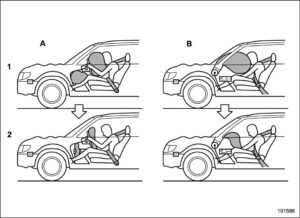
- Driver’s side
- Passenger’s side
- SRS AIRBAGs deploy as soon as a collision occurs.
- After deployment, SRS AIRBAGs start to deflate immediately so that the driver’s vision is not
obstructed.
The SRS airbags can function only when the ignition switch is in the “ON” position. The SUBARU advanced frontal airbag system is designed to determine the activation or deactivation condition of the front passenger’s SRS frontal airbag depending on the characteristic of the item(s) or person on the front passenger’s seat monitored by the front passenger’s occupant detection system sensor. For this reason, only the driver’s SRS frontal airbag may deploy in the event of a collision, but this does not mean failure of the system.If the following sensors detect a predetermined amount of force during a frontal collision, the control module sends signals to the airbag module(s) (only the driver’s module or both driver’s and front passenger’s modules) instructing the module(s) to inflate the SRS frontal airbag(s).
- The front impact sensors
- The impact sensors in the airbag control module On the driver’s side, the SRS knee airbag also inflates with the SRS frontal airbag.
The driver’s and front passenger’s SRS frontal airbags use dual-stage inflators. The two inflators of each airbag are triggered either sequentially or simultaneously, depending on the severity of impact, in the case of the driver’s SRS frontal airbag, and depending on the severity of impact and the characteristic of item(s) or person on the seat in the case of the front passenger’s SRS frontal air-bag.
After deployment
After deployment, the SRS airbag immediately starts to deflate so that the driver’s vision is not obstructed and the driver’s ability to maintain control of the vehicle is not impaired. The time required from detecting impact to the deflation of the SRS airbag after deployment is shorter than the blink of an eye. Both when only the driver’s SRS frontal airbag deploys and the driver’s and front passenger’s SRS frontal airbags deploy, the driver’s and front passenger’s seatbelt pretensioners operate at the same time. When the SRS airbag deploys, a sudden, fairly loud inflation noise will be heard and some smoke will be released. These occurrences are a normal result of the deployment. This smoke does not indicate a fire in the vehicle.
CAUTION
Do not touch the SRS airbag system components around the steering wheel and dashboard with bare hands right after deployment. Doing so can cause burns because the components can be very hot as a result of deployment.
Example of the type of accident
The driver’s SRS frontal airbag and the front passenger’s SRS frontal airbag are designed as follows.
- To deploy in the event of an accident involving a moderate to severe frontal collision
- To function on a one-time-only basis The driver’s SRS frontal airbag and front passenger’s SRS frontal airbag are not designed as follows.
- To deploy in most lesser frontal impacts*1
- To deploy in most side or rear impacts
- Because the necessary protection can be achieved by the seatbelt alone.
- Because deployment of only the driver’s
SRS frontal airbags or both the driver’s and front passenger’s SRS frontal airbags would not protect the occupant in those situations. SRS airbag deployment depends on the level of force experienced in the passenger compartment during a collision. That level differs from one type of collision to another, and it may have no bearing on the visible damage done to the vehicle itself.
Example of an accident in which the driver’s/driver’s and front passenger’s SRS frontal airbag(s) will most likely deploy

A head-on collision against a thick concrete wall at a vehicle speed of 12 to 19 mph (20 to 30 km/h) or higher activates only the driver’s SRS frontal airbag or both the driver’s and front passenger’s SRS frontal airbags. The airbag(s) will also be activated when the vehicle is exposed to a frontal impact similar in fashion and magnitude to the collision described above.
Examples of the types of accidents in which it is possible that the driver’s/driver’s and front passenger’s SRS frontal airbag(s) will deploy

Only the driver’s SRS frontal airbag or both the driver’s and front passenger’s SRS frontal airbags may be activated when the vehicle sustains a hard impact in the undercarriage area from the road surface (such as when the vehicle plunges into a deep ditch, is severely impacted or knocked hard against an obstacle on the road such as a curb).
Examples of the types of accidents in which deployment of the driver’s/driver’s and front passenger’s SRS frontal airbag(s) is unlikely to occur

- The vehicle strikes an object, such as a telephone pole or sign pole.
- The vehicle slides under the load bed of a truck.
- The vehicle sustains an oblique offset frontal impact.
- The vehicle sustains an offset frontal collision.
- The vehicle strikes an object that can move or deform, such as a parked vehicle.
There are many types of collisions that might not necessarily require the deployment of the driver’s/driver’s and front passenger’s SRS frontal airbag(s). In the event of accidents like those illustrated, the driver’s/driver’s and front passenger’s SRS frontal airbag(s) may not deploy depending on the level of accident forces involved. Examples of the types of accidents in which the driver’s/driver’s and front passenger’s SRS frontal airbag(s) are not designed to deploy in most cases

The driver’s and front passenger’s SRS frontal airbags are not designed to deploy in most of the following cases.
- If the vehicle is struck from the side or from behind.
- If the vehicle rolls onto its side or roof.
- If the vehicle is involved in a low-speed frontal collision.
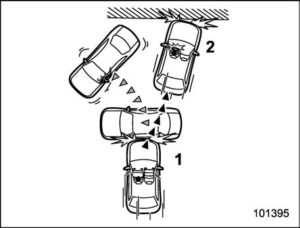
- First Impact
- Second impact
In an accident where the vehicle is impacted more than once, the driver’s and/or front passenger’s SRS frontal airbag(s) will deploy only once on the first impact.
Example: In the case of a double collision, first with another vehicle, then against a concrete wall in immediate succession, once either or both of the driver’s and front passenger’s SRS frontal airbags is/are activated on the first impact, it/they will not be activated on the second impact.
SRS side airbag and SRS curtain airbag
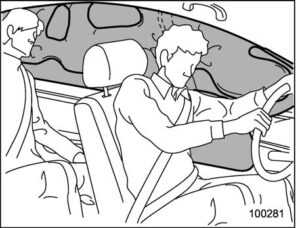
SRS side airbag
The SRS side airbag is stored in the door side of each front seat seatback, which bears an “SRS AIRBAG” label. In a moderate to severe side impact collision, the SRS side airbag on the impacted side of the vehicle deploys between the occupant and the door panel and supplements the seatbelt by reducing the impact on the occupant’s chest and waist. The SRS side airbag operates only for front-seat occupants.
SRS curtain airbag
The SRS curtain airbag on each side of the cabin is stored in the roof side (between the front pillar and a point over the rear seat). An “SRS AIRBAG” mark is located at the top of each center pillar. In a moderate to severe side impact collision, the SRS curtain airbag on the impacted side of the vehicle deploys between the occupant and the side window and supplements the seatbelt by reducing the impact on the occupant’s head. In a rollover, SRS curtain airbags on both sides of the vehicle deploy between the occupant and the side window and supplement the seatbelt by reducing the impact to the occupant’s head. In an offset frontal collision, SRS curtain airbags on both sides of the vehicle deploy between the occupant and the side window and supplement the seatbelt by reducing the impact to the occupant’s head and chest.
Operation
The SRS side airbag and SRS curtain airbag can function only when the ignition switch is in the “ON” position. The following airbags deploy independently of each other since each has its own impact sensor.
- Driver’s SRS side airbag
- Front passenger’s SRS side airbag. SRS curtain airbag (right-hand side) . SRS curtain airbag (left-hand side)
- Therefore, they may not both deploy in the same accident. Also, the SRS side airbag and SRS curtain airbag deploys independently of the driver’s and front passenger’s SRS frontal airbags in the steering wheel and instrument panel. For the locations of the sensors and control modules, refer to “Components”
After deployment
After the deployment, the SRS side airbag immediately starts to deflate. The time required from detection of an impact to deflation of an SRS side airbag after deployment is shorter than the blink of an eye. The SRS curtain airbag remains inflated for a while following deployment then slowly deflates. The SRS side airbag and SRS curtain airbag deploy even when no one occupies the seat on the side on which an impact is applied. When the SRS side airbag and SRS curtain airbag deploy, a sudden, fairly loud inflation noise will be heard and some smoke will be released. These occurrences are a normal result of the deployment. This smoke does not indicate a fire in the vehicle.
CAUTION
Do not touch the SRS side airbag system components around the front seat seatback with bare hands right after deployment. Doing so can cause burns because the components can be very hot as a result of deployment. After deployment, do not touch any part of the SRS curtain airbag system (from the front pillar to the part of the roof side over the rear seat). Doing so can cause burns because the components can be very hot as a result of deployment.
Example of the type of accident
The SRS side airbag and SRS curtain airbag are designed as follows:
- To deploy in the event of an accident involving a moderate to severe side impact collision
- To function on a one-time-only basis The SRS side airbag and SRS curtain airbag are not designed to deploy in the following cases:
- In most lesser side impacts
- In most frontal or rear impacts
(because the SRS side airbag and SRS curtain airbag deployment would not protect the occupant in those situations) The SRS curtain airbags are also designed to deploy when the vehicle is in an extremely inclined state such as during a rollover. They are not designed to deploy in the most lesser-inclined states. SRS side airbag and SRS curtain airbag deployment depend on the level of force experienced in the passenger compartment during a side impact collision. That level differs from one type of collision to another, and it may have no bearing on the visible damage done to the vehicle itself. Example of the type of accident in which the SRS side airbag will most likely deploy
 A severe side impact near the front seat
A severe side impact near the front seat
Examples of the types of accidents in which the SRS curtain airbag will most likely deploy
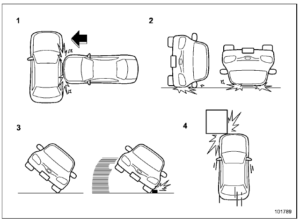
- The vehicle is involved in a severe side impact near the front seat or the rear seat.
- The vehicle rolls onto its side or the roof.
- The angle of vehicle tip-up is marginal or the skidding vehicle’s tires hit a curbstone laterally.
- An offset frontal collision that is severe enough to deploy the front airbag.
Examples of the types of accidents in which it is possible that the SRS side airbag and the SRS curtain airbag will deploy

- Hitting a curb, edge of pavement or hard surface
- Falling into or jumping over a deep hole 3 Landing hard or vehicle falling. It is possible that the SRS side and curtain airbags will deploy if a serious impact occurs to the underside of your vehicle. Some examples are shown in the illustration.
Examples of the types of accidents in which the SRS side airbag is unlikely to deploy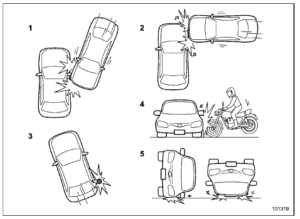
- The vehicle is involved in an oblique side impact.
- The vehicle is involved in a side-on impact in an area outside the vicinity of the passenger compartment.
- The vehicle strikes a telephone pole or similar object.
- The vehicle is involved in a side-on impact from a motorcycle.
- The vehicle rolls onto its side or the roof.
There are many types of collisions that might not necessarily require SRS side airbag deployment. In the event of accidents like those illustrated, the SRS side airbag may not deploy depending on the level of accident forces involved. Examples of the types of accidents in which the SRS curtain airbag is unlikely to deploy
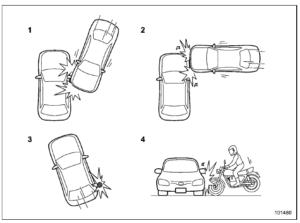
- The vehicle is involved in an oblique side on impact.
- The vehicle is involved in a side-on impact in an area outside the vicinity of the passenger compartment.
- The vehicle strikes a telephone pole or similar object.
- The vehicle is involved in a side-on impact from a motorcycle. There are many types of collisions that might not necessarily require SRS curtain airbag deployment. In the event of accidents like those illustrated, the SRS curtain airbag may not deploy depending on the level of accident forces involved.
Examples of the types of accidents in which the SRS side airbag and SRS curtain airbag are not designed to deploy in most cases

- The vehicle is involved in a frontal collision with another vehicle (moving or stationary).
- The vehicle is struck from behind.
- The vehicle pitches end over end.
In the event of accidents like those illustrated, the SRS side airbag and SRS curtain airbag are not designed to deploy in most cases.
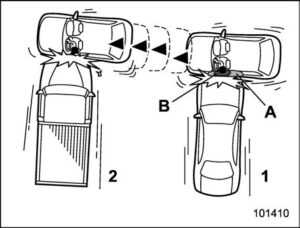
- First impact
- Second impact
- SRS curtain airbag
- SRS side airbag
In an accident where the vehicle is struck from the side more than once, the SRS side airbag and SRS curtain airbag deploy only once on the first impact. Example: In the case of a double side impact collision, first with one vehicle and immediately followed by another from the same direction, once the SRS side airbag and SRS curtain airbag are activated on the first impact, they will not be activated on the second.
FAQ
What is the purpose of the SRS Airbag System in the 2023 Subaru Forester?
The SRS Airbag System is designed to enhance passenger safety by providing additional protection in the event of a collision.
How many airbags are typically included in the 2023 Forester’s SRS system?
The system usually includes multiple airbags, such as front, side, and curtain airbags, to protect occupants from various angles.
Are airbags standard on all trim levels of the 2023 Forester?
Airbags are typically standard across all trim levels of the Forester, prioritizing passenger safety.
Do airbags work in conjunction with seatbelts?
Yes, airbags are most effective when used in conjunction with seatbelts. Passengers should always wear seatbelts for maximum protection.
Can the SRS airbags be disabled or deactivated?
In some models, the front passenger airbag may be deactivated when a rear-facing child safety seat is installed. Refer to the owner’s manual for specific instructions.
Are there any weight or height restrictions for front-seat passengers due to airbag deployment?
While there may not be specific restrictions, it is advisable for passengers to adhere to recommended seating positions for optimal airbag safety.
How does the SRS Airbag System detect a collision?
The system typically uses sensors to detect rapid deceleration, indicating a collision, and triggers airbag deployment.
Can airbags be re-used after deployment?
No, deployed airbags cannot be reused and should be replaced by qualified technicians.
Are there any specific maintenance requirements for the SRS Airbag System?
Maintenance and repairs of the SRS system should only be performed by authorized Subaru technicians to ensure proper functionality.
Are there side airbags in the 2023 Forester to protect against side-impact collisions?
Yes, side airbags are typically included to provide additional protection in side-impact collisions.
What precautions should be taken when installing child safety seats near airbags?
Child safety seats should be placed in the rear seats to avoid deploying front airbags into the child seat. Follow the manufacturer’s guidelines for proper installation.
Can the SRS Airbag System be turned off or deactivated manually?
The SRS system is typically designed to activate automatically when needed and cannot be turned off manually for safety reasons.
Are there any indicators or warning lights for the SRS Airbag System on the dashboard?
Yes, the dashboard usually includes an SRS airbag warning light that indicates system status. If it stays illuminated or flashes, it requires attention from a Subaru dealership.
Do airbags provide protection in rollover incidents?
While airbags primarily offer protection in frontal and side collisions, they may deploy in some rollover situations to enhance passenger safety.
Are there specific guidelines for using aftermarket accessories or modifications related to the SRS Airbag System?
Subaru recommends against aftermarket modifications that could affect the SRS system’s functionality, as these can compromise safety.
Useful Link
View Full User Guide: Subaru Forester 2023 Base User Guide
Download Manuals: https://www.subaru.com/owners/vehicle-resources/manuals.htm
2023 Subaru Forester Specs, Price, Features, Mileage (Brochure)

